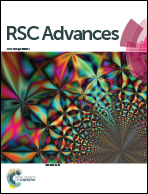Methane decomposition over unsupported mesoporous nickel ferrites: effect of reaction temperature on the catalytic activity and properties of the produced nanocarbon
Abstract
The thermocatalytic decomposition of methane is a promising route for the simultaneous production of COx-free hydrogen and nanocarbon. In this work, unsupported mesoporous nickel ferrites were successfully synthesized via a facile co-precipitation method and used to catalyze the decomposition of methane. The as-prepared nickel ferrites were characterized by using X-ray diffraction, energy dispersive X-ray spectroscopy, scanning and transmission electron microscopy, X-ray photoelectron spectroscopy, N2 adsorption and temperature-programmed reduction analysis. The NiFe2O4 catalyst was found to be highly phase pure and porous. The porosity is resulted from the inter-aggregation of more or less spherical nickel ferrite particles. Moreover, these particles had a total specific surface area of 21 m2 g−1 with a monomodal mesoporous distribution. The catalytic performance of the catalysts was evaluated for methane decomposition at various reaction temperatures, and the dependence of the properties of the nanocarbon on reaction temperature was investigated in detail. Upon increasing the temperature from 700 °C to 900 °C, the yields of hydrogen and nanocarbon increased significantly. A maximum hydrogen yield of 68% was observed over the catalyst at 900 °C within the first 20 minutes of time on the stream. After that, its activity slightly declined, and at the end of 360 minutes, the hydrogen yield was measured to be 47%. At 700 °C and 800 °C, maximum hydrogen yields of 41% and 58% were achieved within 90 minutes of time on stream. No deactivation was observed for the catalyst at any of the temperatures tested, which was attributed to the formation of NiFe bimetallic alloys, which in turn increased the carbon diffusion rate and prevented deactivation of the catalyst. The effect of reaction temperature on the crystalline, morphological and graphitization properties of the deposited nanocarbon was studied. Metal-encapsulated carbon particles with a nano-onion-like appearance and multi-layered graphene sheets were deposited over the catalyst at 700 °C and 900 °C, respectively. Moreover, the crystallinity and graphitization degree of the deposited nanocarbon was found to increase with increasing reaction temperature.


 Please wait while we load your content...
Please wait while we load your content...